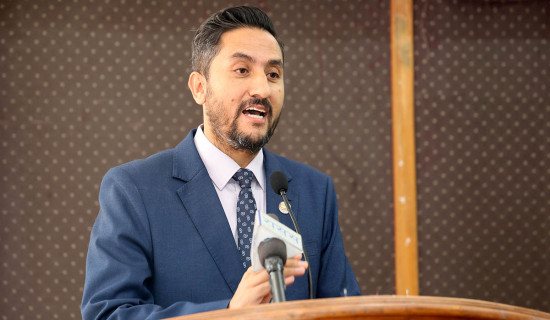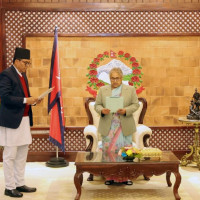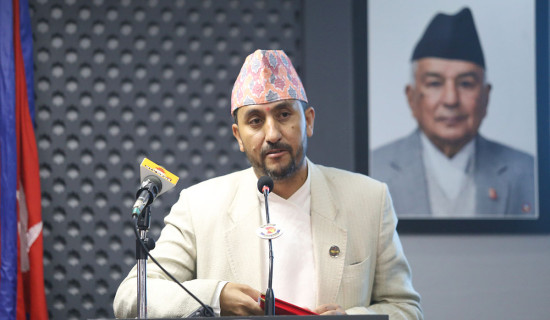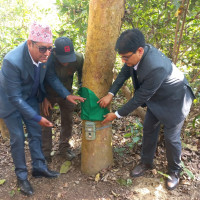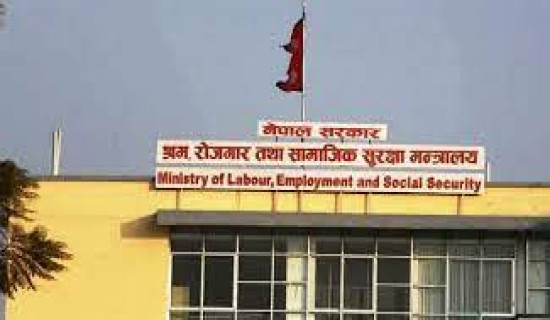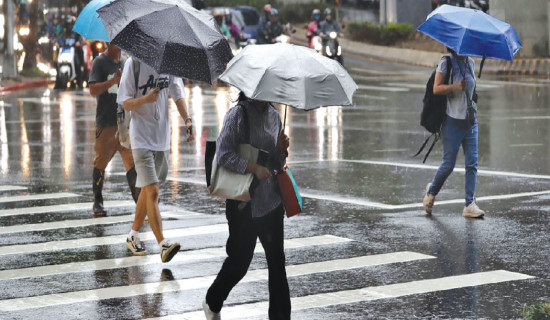- Tuesday, 16 December 2025
Extreme rain and poor urban plan contributed bigger losses
Kathmandu, Oct. 3:The monsoon-triggered floods and landslides on September 27 and 28 claimed at least 231 lives (as of October 2) with some individuals still missing. The fatalities were reported from 22 of the most affected districts, with the majority occurring in the Kavre and Lalitpur districts.
The unprecedented rainfall broke the record in 25 rainfall monitoring stations across the country with the highest recorded rainfall in Daman, Makwanpur, where 410 mm of rainfall was measured on September 28. Earlier, the highest rainfall recorded there was 373.2 mm on July 23, 1993.
Even though the Department of Hydrology and Meteorology had issued early warnings for very heavy to extreme rainfall during the days, many people lost their lives to floods and landslides. According to the preliminary estimation by the Home Ministry, the country has to bear the loss of Rs. 3.55 billion for drinking water Rs. 2.52 billion for roads, Rs. 4 billion for energy sector and Rs. 1 billion for irrigation, according to National Disaster Risk Reduction and Management Authority.
What went wrong?
Despite the early warning system being accurate and disseminated on time, the country’s administrative body was unprepared for rescue operations, leading to significant loss of life. Climate change expert Madhukar Upadhyay stated that the administrative system failed during the disaster.
While the Nepali Army has the authority to act independently, other responsible authorities must wait for permission. Consequently, when the disaster struck on Friday and Saturday morning, the Disaster Management Executive Committee convened a meeting at 9 AM on Saturday, by which time many lives had already been lost. “Three days is sufficient for preparedness, yet the committee failed
to prioritize the deployment of rescue teams,” he remarked.
Areas such as Teku, Nakkhu, Balkhu, and many lowland regions in Kathmandu were at high risk of flooding, as were several highland areas. The government should have kept rescue teams on alert and coordinated information updates every five minutes with local authorities. This represents a significant failure, Upadhyay concluded.
The government has reported that 37 highways were blocked due to floods and landslides, of which nine have already been reopened. Additionally, 34 ongoing hydropower projects have suffered damage, and the agricultural sector has incurred losses amounting to Rs. 6 billion.
In the search operations following the disaster, 30,700 security personnel and helicopters have been deployed. It was announced at a press conference that efforts are being made to expedite relief and rescue operations and to clear the blocked roads
Mandira Singh Shrestha, Senior Water Resources Specialist at ICIMOD, said that although timely forecasts and warnings were issued, it remains unclear whether this information reached the local levels.
“If timely action was taken, we could have minimized the loss of human lives and property. Improving risk communication and coordination at all levels and raising awareness of communities living close to the floodplains is essential,” she said.
The total rainfall from 27 to 28 September in Kathmandu Valley in many places exceeded 300 mm.
Bibhuti Pokharel, Chief of the Climate Section at the Department of Hydrology and Meteorology (DHM), said that while they issued a red alert notice, other relevant authorities should fulfil their roles during a disaster.
“Precipitation during the monsoon period is normal, it can sometimes be active and other times dormant. However, the record-breaking rainfall was unexpected,” she said.
The temperature in September compared to earlier years also set new records. Several stations across the country reported maximum temperatures higher than in previous years, she noted.
According to Sudarshan Humagain, a meteorologist at the DHM, temperature measurement stations including Janakpur Airport, Tarahara, Khandbari, Taplejung, Kankai, Ghorai in Dang, Dhulikhel, Bahrabise, Khumaltar, Changunarayan, Khokana, Baglung, Chapakot, Gorkha, and Kathmandu Airport recorded unprecedented temperatures this September compared to previous years.
Pokharel stressed that there is no time to be complacent; we must improve our service and early warning systems as extreme weather becomes more likely. “This is new for us, but we may experience more frequent extreme rainfall and weather phenomena in the future. Therefore, we need to prioritize effective service delivery and an updated forecasting system,” she stated.
Climate change?
Upadhyaya said that the intensity of rainfall can be linked to the effects of climate change. While rainfall has typically been recorded in the eastern and western parts of the country, the central region, which has historically experienced less rainfall, recorded extreme rainfall this time. He said the changes in both the pattern of rainfall and the timing of monsoon withdrawal, can also be attributed to the impacts of climate change.
Pokharel said that the record-breaking temperatures and rainfall can be linked to the impacts of climate change. “The effects of climate change may become more pronounced in the future, so there needs to be an effective mechanism in place to address potential threats,” she said.
“I have never before seen flooding on this scale in Kathmandu,” said Arun Bhakta Shrestha, Climate and Environmental Risks Lead at the Hindu Kush Himalayan Knowledge Centre, ICIMOD.
“The recent flood disaster in Kathmandu was the result of a combination of extreme rainfall and poor urban development. Unusually heavy rainfall occurred in the last week of September, which is abnormally late in the monsoon season.
Some weather stations in Kathmandu recorded the highest-ever 24-hour rainfall during this period. These factors strongly suggest that climate change played a significant role in exacerbating the disaster, compounded by poor urban planning and infrastructure,” he said.



